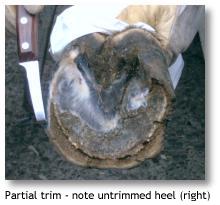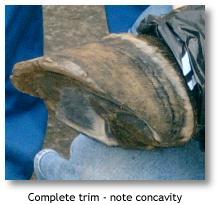

|
A r t i c l e s A n d C a s e
S t u d i e s
Dr Hiltrud Strasser's Basic Hoof Care
Clinic - Part Two
New Zealand, January, 2002
By Teresa Maxwell
In this Article: The
Effects of Shoeing, The Correct Trim, The
Transition Period.
(Click on the images for a larger
view)

The Effects of Shoeing
Dr Strasser lectured in detail about the adverse
effects of shoeing, and how a healthy natural hoof
without shoes provides better health for the horse,
superior traction and shock absorption and higher
performance if conditioned correctly in combination
with natural living conditions.
"The fact that the horse, when given proper living
conditions and treated correctly, is capable of the
greatest feats without hoof protection has been
known for thousands of years," Dr Strasser
says.
"Neither Alexander the Great's cavalry nor the
horses of the present-day nomadic tribes of the
Asian steppes, which cover tremendous distances,
require any kind of hoof wear."
Shoes impair the hoof mechanism, and reduce shock
absorption with the fixation of the wall, causing
the impact to travel up the leg and stress the
joints, etc. It also causes ossifications, stresses
the heart, and reduces circulation.
The vibration of shoes is 800Hz, which destroys
hoof wall and tissue, causes structural
abnormalities in the laminar corium, causes
irritation of ligament and tendon attachments to
the periosteum of bones and joint cartilage.
Dr Strasser told us that studies show there is
many times more shock impact on joints in a shod
horse walking on concrete than an unshod horse with
a correct trim trotting on concrete.
Shoes prevent the hoof wall from wearing properly,
which causes unnatural stresses, and an incorrect
trim cannot wear away. Shoes also cause physical
trauma (bruising, etc), unnatural strains on joints
and ligaments, deformation and contraction of the
hoof, causing navicular syndrome, thrush, skeletal
and muscular stresses, and prevents proper
development of young horses' feet and coffin bone.
(Dr Strasser says many New Zealand thoroughbreds
have terrible feet because they are shod too young
- before the bones in the hoof have developed.)
Nails cause physical damage to the hoof wall,
dehydration of the white line horn, vibrations and
breaches insulation of the foot.

The Correct Trim:
However, simply taking the shoes off may not be
enough to fix problems caused by shoeing if the
horse doesn't have optimal natural living
conditions - and few domestic horses do. For this
reason, it is important to apply the correct hoof
trim.
For those of us who had never picked up a hoof
knife, learning how to trim a horse's hoof was
fascinating - and hard work! Putting it into
practise meant getting the right techniques with
the tools - chiefly a hoof knife - know where to
cut, how to cut and how far you can go without
damaging the hoof. The class practiced the hoof
trim using cadaver hooves, pretty disgusting but at
least the horse didn't care if you got it
wrong.
Dr Strasser's trim involves getting the coffin
bone parallel to the ground, which means the weight
is distributed evenly on the hoof capsule, the hoof
wears evenly and functions correctly with maximum
hoof mechanism.
In other words, when the horse puts weight on its
hoof, the hoof expands. If the horse is shod or has
an incorrect trim, the hoof will not expand when
the horse puts weight on it, which is unnatural and
causes deformity in the hoof and health problems
for the horse.
The main cause of this lack of expansion or
correct hoof mechanism is excessive bars or sole,
which puts pressure on the bones inside the hoof
(causing such things as navicular and laminitis)
and puts pressure on the outside of the hoof
(causing such things as hoof cracks).
The cure is to remove excess bars and sole, and
get the coffin bone parallel to the ground. As we
cannot see the coffin bone without an xray, Dr
Strasser says an outward indication that the coffin
bone is parallel to the ground is if the coronet
band is on a 30 degree angle to the ground looking
at the hoof from the side.
To achieve this, the heels must be 3.5cm from the
ground to the tip of the lateral cartilage, which
can be felt as a ridge above the heel bulbs. The
sole should be concave, with the midway point of
the bars 1cm higher than the ground when the horse
has its foot on the ground. This is so the bars and
excessive sole don't put incorrect pressures on the
hoof.
The widest part of the frog should be wider than
the heel bulbs - ie; if two imaginary lines were
drawn from the tip of the frog along the edges of
the frog to out past the heels, these lines should
pass outside the curves of the heel bulbs. If they
don't, the hoof is deformed, ie; contracted.
The front hooves from the coronet band to the tip
of the toe should be on a 45 degree angle to the
ground, and the back hooves approximately 55
degrees, when the coffin bone is ground
parallel.
The Transition Period
"After many years of shoeing, it is not possible
to simply remove the shoe and expect the horse to
be immediately and fully sound and usable," Dr
Strasser says.
When the shoes are removed and a correct trim is
applied, circulation immediately returns to the
hoof enabling the horse to feel the damage caused
by the shoes. This means the horse can all of a
sudden feel its hooves and needs time for the hoof
to toughen and adjust.
Once the horse's hooves have been trimmed
correctly, the horse must be given optimal
circulation to promote the quickest healing. This
means freedom of movement 24 hours a day -
"movement, movement, movement".
Over the three-day course, we learnt that all
horses, irrespective of breed, background or
current status of health, can be restored to a
healthy condition, with the horse able to be used
for whatever you want to use the hrse for -
dressage, jumping, endurance, pleasure riding, etc.
This transition period to healthy hooves can take
anything from a few weeks for reasonably sound
horses to 10 months or more, for horses with
severly deformed hooves.
"The statement 'I can't ride my horse without
shoes' is not a reason to shoe, but rather a reason
to investigate and remove the causes which have
brought the hooves into such poor condition that
the horse can no longer exist without the crutch of
the shoe," Dr Strasser says.
"When, as a young horse, before it was ever shod,
it was perfectly able to move, and run, and
play."
By Teresa Ramsey
More Photos - see a
full set of photos from both the Chapman and
Strasser clinics.
Submit an Article or Case Study
The more we share information, the better off our
horses are going to be. If you'd like to share your
story, please email the
editor.
Disclaimer: Natural Hoof
reserves the right to change or edit any part of
all articles and case studies submitted to this
website. Natural Hoof does not take any
responsibility for the content of any articles
and/or case studies and/or any misapplication of the information presented in any articles. Natural Hoof presumes readers consult a professional for more information about any topic covered in any Natural Hoof article.
Home | Articles | Study Groups | Clinics-Events | Brag | Classifieds |
Order | Links


|
|









